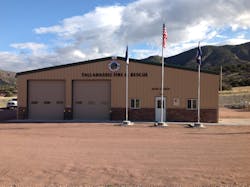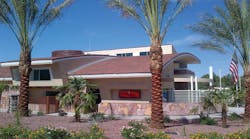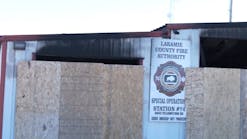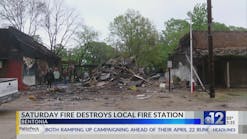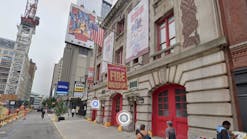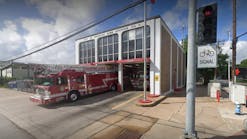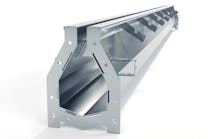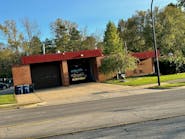As the mission of fire departments today changes, so does the design of fire stations. Volunteer response and paid response are almost identical, both adapting to severe weather events, natural disasters and responding to terrorism, school shootings and aiding police in addition to all current responses such as fire, rescue, EMS, etc. These new and more complicated forms of response translate into new training regimens, different types of apparatus and equipment and more personal risk. Station design must address the risks of the emergency response profession while promoting camaraderie, high levels of training and personal health and safety within the station environment.
Besides recruitment and retention, one of the biggest challenges facing volunteer fire departments is restricting contaminant exposure to volunteers. Toxins and carcinogens from fires are known cancer-causing elements. A recent YouTube video demonstrates the way toxins can adhere to a firefighter and contaminate surrounding areas and people.
Volunteer fire departments need to address these issues the same way career departments need to address the issues: limit exposure to used turnout gear, clean gear after fires and shower after fires. Volunteers, however, frequently carry their turnout gear in their personal vehicle and often don’t return to the station after a call. For volunteer departments this means educating firefighters about contaminants and off-gassing of exposed turnout gear and restricting family exposure to firefighters’ gear and the clothes worn on a call.
Changes to volunteer station designs
Besides training and growth, recruitment and retention are important elements in a successful volunteer fire department—especially with young personnel.
According to Dennis Ross, AIA, Pacheco Ross Architects, P.C., volunteer departments must constantly evaluate their mission and adapt to growth and change. “In order to attract high-quality volunteers, student bunker programs are becoming popular,” said Ross. “Station design must adapt to younger volunteers that value connectivity, constant learning and have more distractions in their personal lives. Therefore, they have less time for keeping up old decrepit facilities and demand facilities that function properly.”
Gender equity is the norm in all fire departments with female firefighters and officers. For volunteer departments, new facilities must anticipate the future and hiring firefighters to supplement increased calls and the decline in volunteers. Both the need for gender-neutral sleeping and restroom facilities must be considered when designing a new volunteer station.
In the northeastern area, Ross sees banquet halls in volunteer departments disappearing. “They are costly to build, difficult to maintain, compete with local businesses and volunteers no longer have the time to operate them,” he said. “Many volunteer stations are identical to paid stations other than the arrival of first responders to a call.”
With 40 years’ experience, Ross has seen an increase in volunteer departments combining with other functions such as police, EMS, courts and other municipal departments. “These functions are paid groups, but the combination of groups can offset construction and operating costs for all involved,” he said.
In more rural areas, volunteer fire departments are struggling to fund basic structures and find it challenging to survive in small towns, with vast response areas and no funding.
Donn Maynard, chief of the Livermore, CO, Fire Department, needs to build a new fire station at the opposite end of his town to accommodate an expanding coverage area. With no money to buy a site, he’s hoping that someone will step up and donate a parcel of land for a new station. Not only will the new site protect equipment and apparatus, but improve camaraderie and culture in the small department. Educating the community to the need for a new station is the task facing Maynard.
Funding and planning
The Tallahassee, CO, Volunteer Fire Department (TVFD) is located three hours southwest of Denver. Twenty-four volunteers respond to a 325-square-mile area and are fiercely proud of their new fire station. And rightly so, the 60-by-66-foot building, at a cost of $197,683, was the result of careful planning and creative funding.
Five years ago when Gordon Gross light took over as fire chief, the department had pick-up trucks, a pole barn and a constant change of staff. With $20,000 in the bank, Grosslight said the first order of business was to develop a 10- to 20-year strategic plan. From that plan, a vision statement was created and to exist, the need for a home for the department became obvious.
With support from 3,000 residents, yet no towns for funding, the fire department was able to secure land, raise money through donations and earn money by providing deployed services throughout the county supporting other fire agencies in the preservation of life and property. Chief Grosslight explained, “The building was paid for from federal deployments.”
The National Wildfire Coordinating Group (NWCG) does not have resources to fight large fires, so TVFD signed on to be a co-operator with the state of Colorado. NWCG pays the cost of a vehicle, per hour and fixed rates to pay a crew. “We provide a fire engine with a crew and over the course of three years made up the financial shortfall to pay for the new station,” the chief said.
The land donated to the department came with a special-use permit that requires only provisions for emergency services or training events. No social activities are permitted at the site.
TVFD’s new station was constructed and put in service for a total of $49.94 per square foot. The facility can house up to six apparatus (normal equipment load is four) and is fully built-out inside with two offices, one for the chief and another for administration/Internet training. A kitchen and two bathrooms (one is ADA compliant) are on the first floor.
On the second floor is a storage room and potential sleeping quarters for the future; currently it is used as a day room. Training is held in the bay area, with access to A/V equipment, an SCBA-fill unit and a vehicle exhaust system.
“This station is the cornerstone for our department’s long-term growth and is a source of pride for our volunteers and community members as well,” Grosslight said.
JANET WILMOTH grew up in a family of firefighters in a suburb of Chicago. Wilmoth, owner of Wilmoth Associates, worked with Fire Chief magazine for 27 years until it closed in 2013. She is currently a Project Director for Firehouse/SouthComm. Wilmoth currently serves on the Board of Directors for the Fire Emergency Manufacturers & Services Association and lives in Lisle, IL.
